

![]()

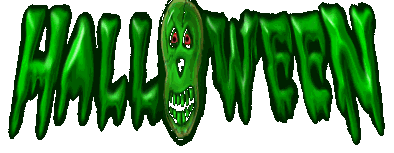


 America
is a melting pot of cultures from all over the world. Because we are a
nation of people from many different cultures, our holidays tend to blend
bits and pieces from different cultures into one American celebration.
Halloween is one of the best examples of a holiday with a rich tradition of
"blending."
America
is a melting pot of cultures from all over the world. Because we are a
nation of people from many different cultures, our holidays tend to blend
bits and pieces from different cultures into one American celebration.
Halloween is one of the best examples of a holiday with a rich tradition of
"blending."
![]() October
31. Halloween. Costumes and Jack O'Lanterns. Trick or Treat and bonfires. We
generally see it as a harmless children's celebration. And it is. Now. The
history of Halloween, however, dates back before Christianity and involves
death and evil spirits and fears of all sorts.
October
31. Halloween. Costumes and Jack O'Lanterns. Trick or Treat and bonfires. We
generally see it as a harmless children's celebration. And it is. Now. The
history of Halloween, however, dates back before Christianity and involves
death and evil spirits and fears of all sorts.
 Let's
start with the date, October 31. When mankind first started to settle down
into villages, there were two sources of food. You farmed and you raised
cattle. Cattle were easy. On May first, you drove the cattle out into your
field. On November first, you brought them back into the barn for the
winter. Your entire year was two seasons - growing season and winter. Life
and Death. Beltane and Samhain. Since November first was the start of the
season of death, when food grew scarce and the plants all died, it was also
the night to honor the Lord of the Dead, Anwinn. The belief was that spirits
of those who had died during that year also gathered that night, driven out
of the bare woods and empty fields. The spirits returned to their homes and
needed the help of their kin to cross over to the land of the dead.
Relatives would hollow out turnips and gourds and use them to carry the
spirits to the proper location.
Let's
start with the date, October 31. When mankind first started to settle down
into villages, there were two sources of food. You farmed and you raised
cattle. Cattle were easy. On May first, you drove the cattle out into your
field. On November first, you brought them back into the barn for the
winter. Your entire year was two seasons - growing season and winter. Life
and Death. Beltane and Samhain. Since November first was the start of the
season of death, when food grew scarce and the plants all died, it was also
the night to honor the Lord of the Dead, Anwinn. The belief was that spirits
of those who had died during that year also gathered that night, driven out
of the bare woods and empty fields. The spirits returned to their homes and
needed the help of their kin to cross over to the land of the dead.
Relatives would hollow out turnips and gourds and use them to carry the
spirits to the proper location.
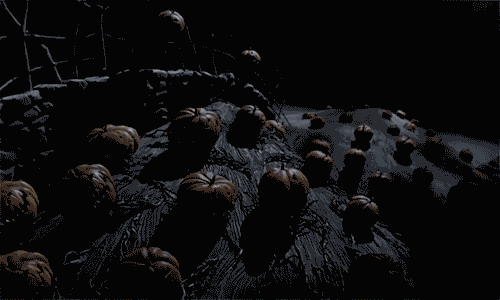
Not just
good spirits were loose on Samhain - evil spirits, witches and goblins also
roamed the earth. To protect your relative's spirit, you'd paint a scary
face on the gourd to chase the evil spirits away. And to play it safe, you'd
also disguise yourself by painting your face with hideous paints and donning
a wild costume.
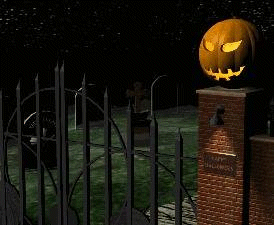 This
just left the problem of the faeries. Faeries also ran free on the Eve of
Samhain. Faeries weren't evil, they weren't good. They were faeries. They
liked rewarding good deeds and did not like to be crossed. And on Samhain,
the faeries would disguise themselves as beggars and go door to door asking
for handouts. Those who gave them food were rewarded. Those who slammed the
door tended to experience some unpleasantness.
This
just left the problem of the faeries. Faeries also ran free on the Eve of
Samhain. Faeries weren't evil, they weren't good. They were faeries. They
liked rewarding good deeds and did not like to be crossed. And on Samhain,
the faeries would disguise themselves as beggars and go door to door asking
for handouts. Those who gave them food were rewarded. Those who slammed the
door tended to experience some unpleasantness.
 Bonfires
were very popular part of the ceremony in the Celtic countries. In Ireland,
the fires were all allowed to go out. A large bonfire was lit in the center
of town and sacrifices were thrown in. From this one central bonfire in each
town, all the hearths and fireplaces were re lit. The same ceremony took
place in Scotland, but the Scots also believed that you could tell the
future by staring into the bonfire.
Bonfires
were very popular part of the ceremony in the Celtic countries. In Ireland,
the fires were all allowed to go out. A large bonfire was lit in the center
of town and sacrifices were thrown in. From this one central bonfire in each
town, all the hearths and fireplaces were re lit. The same ceremony took
place in Scotland, but the Scots also believed that you could tell the
future by staring into the bonfire.
In
43 AD, the Roman Empire conquered the Celts and Celts and Romans found
themselves living in the same villages. The Celtic festival of Samhain was
celebrated at the same time as Pomona, a Roman celebration of the harvest.
As the two cultures lived together, their cultures began to merge and
suddenly apples and harvests became part of the celebration.
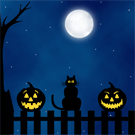 Readers
will notice that until now we haven't actually said the word Halloween. This
is because it still didn't exist. Over the next 500 years, the Catholic
Church grew in power until, under Pope Gregory, it had converted most of
Europe and the British Islands to Christianity. Pope Gregory's successor,
Pope Boniface 4th, desperately wanted to eliminate pagan ceremonies. Pope
Boniface felt that as long as the old festivals were still celebrated, the
church's control wasn't complete. He also knew that if he banned the
festivals, he'd have a full blown riot on his hands. So he decided to
replace the old festival with a new festival and the church created All
Saints' Day, a holy day to honor all the saints.
Readers
will notice that until now we haven't actually said the word Halloween. This
is because it still didn't exist. Over the next 500 years, the Catholic
Church grew in power until, under Pope Gregory, it had converted most of
Europe and the British Islands to Christianity. Pope Gregory's successor,
Pope Boniface 4th, desperately wanted to eliminate pagan ceremonies. Pope
Boniface felt that as long as the old festivals were still celebrated, the
church's control wasn't complete. He also knew that if he banned the
festivals, he'd have a full blown riot on his hands. So he decided to
replace the old festival with a new festival and the church created All
Saints' Day, a holy day to honor all the saints.
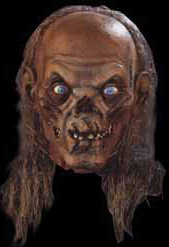
The
problem with All Saints' Day was it was a holy day, not a festival. The
people simply celebrated both of them. Two hundred years later the church
had still not succeeded in getting rid of the pagan holiday. Pope Gregory
the 3rd, however, had a new idea. He changed the rules so that All Saints'
day always fell on the exact day as Samhain. And to celebrate All Saints'
Day, young men were to go door to door begging for food for the town poor.
Villagers were allowed to dress up in costume to represent a saint. Now,
instead of dressing up to chase away evil spirits, you dressed up to honor
the saints.
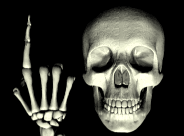
 For
the next 700 years, the Church felt it had won the battle because the Celts
celebrated All Saints' Day. The Celts, on the other hand, thought they had
won because they still had their holiday with the original ceremonies.
Neither realized that Samhain and All Saints' Day were blurring into one
holiday. By the 1500's, you couldn't separate the two anymore. Of course, by
this time, no one called it All Saints' Day. Now it was All Hallows' Day.
The night before All Hallows' Day was of course, All Hallows' Evening, or in
the slang of the villagers, Hallow Evening or simply Halloween.
For
the next 700 years, the Church felt it had won the battle because the Celts
celebrated All Saints' Day. The Celts, on the other hand, thought they had
won because they still had their holiday with the original ceremonies.
Neither realized that Samhain and All Saints' Day were blurring into one
holiday. By the 1500's, you couldn't separate the two anymore. Of course, by
this time, no one called it All Saints' Day. Now it was All Hallows' Day.
The night before All Hallows' Day was of course, All Hallows' Evening, or in
the slang of the villagers, Hallow Evening or simply Halloween.
 This
may have been the end of it except for one significant development. On
Halloween, 1517, Martin Luthor began trying to reform the Catholic Church.
His reformation ended up as the Protestant Church, the followers of which
didn't believe in saints. No saints meant no All Hallows' Day. No All
Hallows' Day meant no Halloween.
This
may have been the end of it except for one significant development. On
Halloween, 1517, Martin Luthor began trying to reform the Catholic Church.
His reformation ended up as the Protestant Church, the followers of which
didn't believe in saints. No saints meant no All Hallows' Day. No All
Hallows' Day meant no Halloween.
 The Celts have never given up a party
without a fight, so the Halloween festivities were moved to November 5 - Guy
Fawkes Day. Guy Fawkes was a minor player in a Catholic plot to blow up the
English Parliament, which was Protestant. So, although technically, the
celebration was to commemorate the failure of the plot, it was Halloween.
Bonfires were lit across the country. People made lanterns from carved out
turnips and children went begging for money.
The Celts have never given up a party
without a fight, so the Halloween festivities were moved to November 5 - Guy
Fawkes Day. Guy Fawkes was a minor player in a Catholic plot to blow up the
English Parliament, which was Protestant. So, although technically, the
celebration was to commemorate the failure of the plot, it was Halloween.
Bonfires were lit across the country. People made lanterns from carved out
turnips and children went begging for money.
 Meanwhile,
in the new world, the settlers were all Protestant and Halloween was
technically a Catholic holiday. The original colonists in this country found
ANY celebration immoral, never mind a Catholic one. In fact, celebrating
Christmas in the Massachusetts colony was illegal, punishable by banishment
or death.
Meanwhile,
in the new world, the settlers were all Protestant and Halloween was
technically a Catholic holiday. The original colonists in this country found
ANY celebration immoral, never mind a Catholic one. In fact, celebrating
Christmas in the Massachusetts colony was illegal, punishable by banishment
or death.
 After
the American Revolution, Halloween still never really caught on in America.
Most of the country was farmland, and the people too far spread out to share
different celebrations from Europe. Any chance to get together was looked
forward to - barn raisings, quilting bees, taffy pulls. Eventually, a fall
holiday called the Autumn Play Party developed. People would gather and tell
ghost stories, dance and sing and feast and light bonfires. The children
would stage a school pageant where they paraded in costumes. Sound familiar?
After
the American Revolution, Halloween still never really caught on in America.
Most of the country was farmland, and the people too far spread out to share
different celebrations from Europe. Any chance to get together was looked
forward to - barn raisings, quilting bees, taffy pulls. Eventually, a fall
holiday called the Autumn Play Party developed. People would gather and tell
ghost stories, dance and sing and feast and light bonfires. The children
would stage a school pageant where they paraded in costumes. Sound familiar?
 The
Autumn Play Parties lasted until the Industrial revolution. After that, the
majority of Americans lived in cities and had no need for such get
togethers. By the end of the Civil War, only Episcopalians and Catholics
celebrated All Saints' Day and Halloween, and the two religions combined
made up less than 5% of the population. Concerned about letting a part of
their heritage fade away, the the two religions began an aggressive campaign
to put those two holidays on all public calendars. The first year All
Saints' Day and Halloween showed up on the calendars, the newspapers and
magazines made a big deal about it. Suddenly, everyone knew about Halloween
and began celebrating it by lighting bonfires and having masquerade parties.
The
Autumn Play Parties lasted until the Industrial revolution. After that, the
majority of Americans lived in cities and had no need for such get
togethers. By the end of the Civil War, only Episcopalians and Catholics
celebrated All Saints' Day and Halloween, and the two religions combined
made up less than 5% of the population. Concerned about letting a part of
their heritage fade away, the the two religions began an aggressive campaign
to put those two holidays on all public calendars. The first year All
Saints' Day and Halloween showed up on the calendars, the newspapers and
magazines made a big deal about it. Suddenly, everyone knew about Halloween
and began celebrating it by lighting bonfires and having masquerade parties.

In the late
1800's, nearly 7.4 million immigrants came to America, bringing their
European customs with them. Seven hundred thousand Irish Catholics came over
during the seven-year potato famine alone. These immigrants may have brought
their customs with them, but once they saw how plentiful pumpkins were in
the New World, it didn't take them long to start hollowing out jack
O'lanterns instead of turnips.
 In
1921, Anoka, Minnesota celebrated the first official city wide observation
of Halloween with a pumpkin bowl, a costumed square dance and two parades.
After that, it didn't take Halloween long to go nationwide. New York started
celebrating in 1923 and LA in 1925. By then, not only had Jack O'Lanterns
replaced the hollowed out turnips, but the disguised fairies begging door to
door had become trick or treat. Bonfires remained popular, but not for
relighting fires and telling the future.
In
1921, Anoka, Minnesota celebrated the first official city wide observation
of Halloween with a pumpkin bowl, a costumed square dance and two parades.
After that, it didn't take Halloween long to go nationwide. New York started
celebrating in 1923 and LA in 1925. By then, not only had Jack O'Lanterns
replaced the hollowed out turnips, but the disguised fairies begging door to
door had become trick or treat. Bonfires remained popular, but not for
relighting fires and telling the future.
 So
if it appears on October 31 that the wind sounds a little too mournful as it
whistles through the skeletal fingers of the bare trees, it's only your
imagination. And if the nip in the air seems to bear the chilling touch of
the grave on it, it's only fall foreshadowing the arrival of winter. It has
nothing to do with the ghosts and goblins that once called this night their
own. And as you peer out into the stygian blackness of this night, if
something should rustle through the dead leaves, just remember that the
faeries dance no more in the realms of man. - It is only Halloween.
So
if it appears on October 31 that the wind sounds a little too mournful as it
whistles through the skeletal fingers of the bare trees, it's only your
imagination. And if the nip in the air seems to bear the chilling touch of
the grave on it, it's only fall foreshadowing the arrival of winter. It has
nothing to do with the ghosts and goblins that once called this night their
own. And as you peer out into the stygian blackness of this night, if
something should rustle through the dead leaves, just remember that the
faeries dance no more in the realms of man. - It is only Halloween.
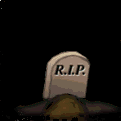
Music On/Off